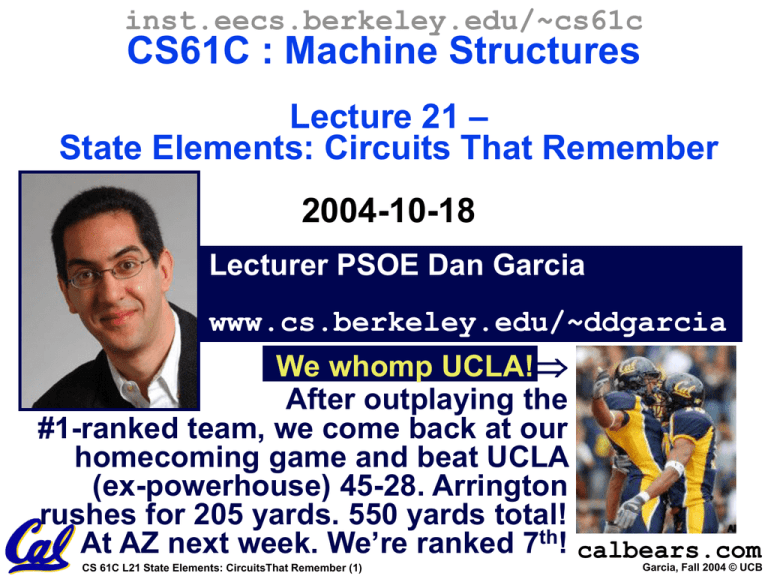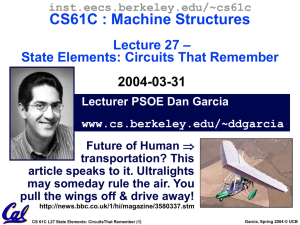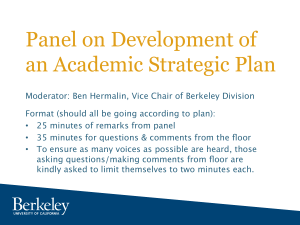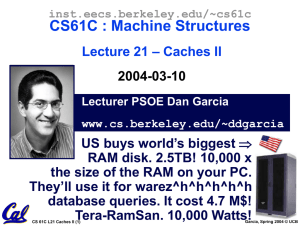CS61C : Machine Structures – Lecture 21 State Elements: Circuits That Remember
advertisement

inst.eecs.berkeley.edu/~cs61c CS61C : Machine Structures Lecture 21 – State Elements: Circuits That Remember 2004-10-18 Lecturer PSOE Dan Garcia www.cs.berkeley.edu/~ddgarcia We whomp UCLA! After outplaying the #1-ranked team, we come back at our homecoming game and beat UCLA (ex-powerhouse) 45-28. Arrington rushes for 205 yards. 550 yards total! At AZ next week. We’re ranked 7th! calbears.com CS 61C L21 State Elements: CircuitsThat Remember (1) Garcia, Fall 2004 © UCB Review… • ISA is very important abstraction layer • Contract between HW and SW • Basic building blocks are logic gates • Clocks control pulse of our circuits • Voltages are analog, quantized to 0/1 • Circuit delays are fact of life • Two types • Stateless Combinational Logic (&,|,~), in which output is function of input only • State circuits (e.g., registers) CS 61C L21 State Elements: CircuitsThat Remember (2) Garcia, Fall 2004 © UCB Accumulator Example Want: S=0; for i from 0 to n-1 S = S + Xi CS 61C L21 State Elements: CircuitsThat Remember (3) Garcia, Fall 2004 © UCB First try…Does this work? Feedback! Nope! Reason #1… What is there to control the next iteration of the ‘for’ loop? Reason #2… How do we say: ‘S=0’? CS 61C L21 State Elements: CircuitsThat Remember (4) Garcia, Fall 2004 © UCB Second try…How about this? Yep! Rough timing… CS 61C L21 State Elements: CircuitsThat Remember (5) Garcia, Fall 2004 © UCB Register Details…What’s in it anyway? • n instances of a “Flip-Flop”, called that because the output flips and flops betw. 0,1 • D is “data” • Q is “output” • Also called “d-q Flip-Flop”,“d-type Flip-Flop” CS 61C L21 State Elements: CircuitsThat Remember (6) Garcia, Fall 2004 © UCB What’s the timing of a Flip-flop? (1/2) • Edge-triggered d-type flip-flop • This one is “positive edge-triggered” • “On the rising edge of the clock, the input d is sampled and transferred to the output. At all other times, the input d is ignored.” CS 61C L21 State Elements: CircuitsThat Remember (7) Garcia, Fall 2004 © UCB What’s the timing of a Flip-flop? (2/2) • Edge-triggered d-type flip-flop • This one is “positive edge-triggered” • “On the rising edge of the clock, the input d is sampled and transferred to the output. At all other times, the input d is ignored.” CS 61C L21 State Elements: CircuitsThat Remember (8) Garcia, Fall 2004 © UCB Administrivia • Midterm tonight! • 1 Pimintel 7pm-10pm CS 61C L21 State Elements: CircuitsThat Remember (9) Garcia, Fall 2004 © UCB Accumulator Revisited (proper timing 1/2) CS 61C L21 State Elements: CircuitsThat Remember (10) Garcia, Fall 2004 © UCB Accumulator Revisited (proper timing 2/2) CS 61C L21 State Elements: CircuitsThat Remember (11) Garcia, Fall 2004 © UCB Pipelining to improve performance (1/2) Timing… CS 61C L21 State Elements: CircuitsThat Remember (12) Garcia, Fall 2004 © UCB Pipelining to improve performance (2/2) Timing… CS 61C L21 State Elements: CircuitsThat Remember (13) Garcia, Fall 2004 © UCB Finite State Machines Introduction CS 61C L21 State Elements: CircuitsThat Remember (14) Garcia, Fall 2004 © UCB Finite State Machine Example: 3 ones… Draw the FSM… Truth table… PS Input NS Output 00 0 00 0 00 1 01 0 01 0 00 0 01 1 10 0 10 0 00 0 10 1 00 1 CS 61C L21 State Elements: CircuitsThat Remember (15) Garcia, Fall 2004 © UCB Hardware Implementation of FSM + = ? CS 61C L21 State Elements: CircuitsThat Remember (16) Garcia, Fall 2004 © UCB General Model for Synchronous Systems CS 61C L21 State Elements: CircuitsThat Remember (17) Garcia, Fall 2004 © UCB Peer Instruction A. HW feedback akin to SW recursion B. We can implement a D-Q flipflop as simple CL (And, Or, Not gates) C. You can build a FSM to signal when an equal number of 0s and 1s has appeared in the input. CS 61C L21 State Elements: CircuitsThat Remember (18) 1: 2: 3: 4: 5: 6: 7: 8: ABC FFF FFT FTF FTT TFF TFT TTF TTT Garcia, Fall 2004 © UCB Peer Instruction Answer A. It needs ‘base case’ (reg reset), way to step from i to i+1 (use register + clock). ° True! B. D-Q has state, CL never has state! ° False! C. How many states would it have? Say it’s n. How does it know when n+1 bits have been seen? ° False! A. HW feedback akin to SW recursion B. We can implement a D-Q flipflop as simple CL (And, Or, Not gates) C. You can build a FSM to signal when an equal number of 0s and 1s has appeared in the input. CS 61C L21 State Elements: CircuitsThat Remember (19) 1: 2: 3: 4: 5: 6: 7: 8: ABC FFF FFT FTF FTT TFF TFT TTF TTT Garcia, Fall 2004 © UCB “And In conclusion…” • We use feedback to maintain state • Register files used to build memories • D-FlipFlops used to build Register files • Clocks tell us when D-FlipFlops change • Setup and Hold times important • We pipeline big-delay CL for faster clock • Finite State Machines extremely useful • You’ll see them in HW classes (150,152) & 164 CS 61C L21 State Elements: CircuitsThat Remember (20) Garcia, Fall 2004 © UCB



